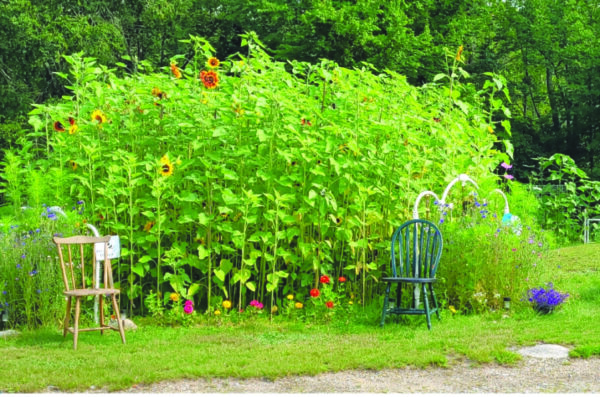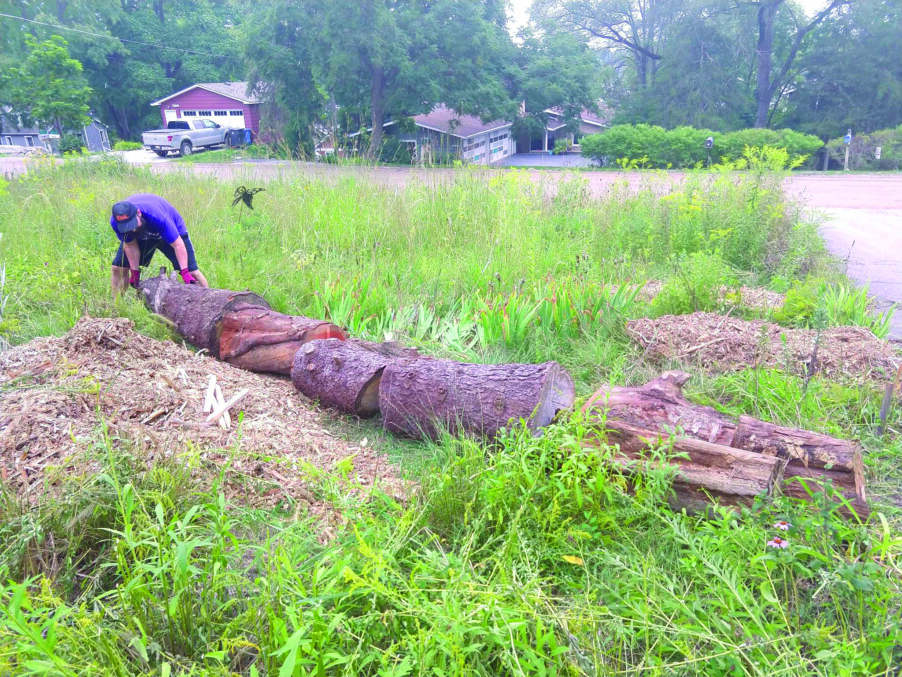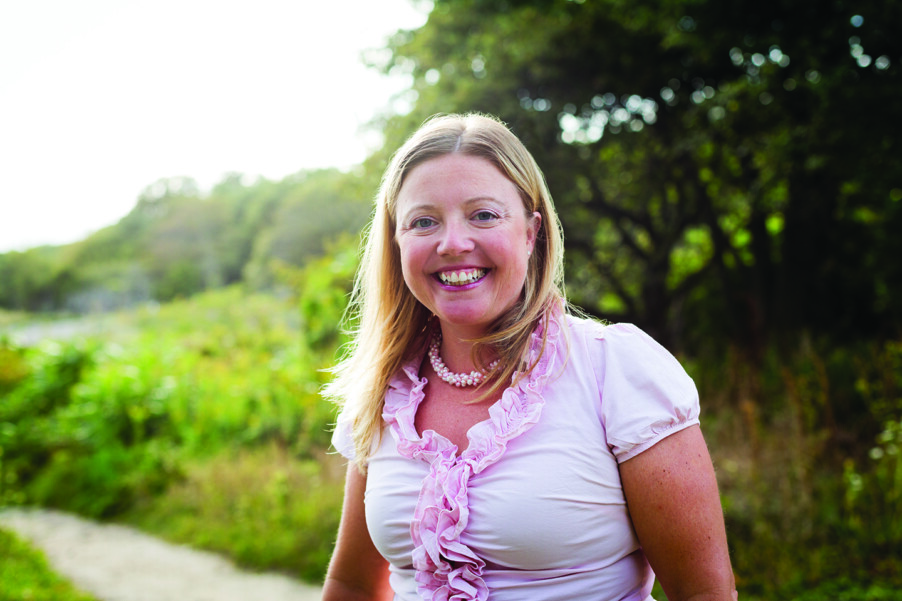And more advice on how to make your garden healthier, hardier and more exciting
By Matt Ingersoll and Angie Sykeny
news@hippopress.com
There are all kinds of unique and cost-effective ways to make your garden stand out. Here are some ideas gathered from discussions with local gardening experts on how to get started.
Healthier soils
Most fruits and vegetables grow best in a well-drained sandy loam soil, rich in organic matter with a pH level (a measure of acidity) between 6.5 and 6.8. Exceptions are potatoes, which have a different pH requirement, and blueberries, which need a pH level of between 4.5 and 5.
Nate Bernitz, public engagement program manager for the UNH Cooperative Extension, recommends gardeners test their soil for pH levels before using it, ideally at least six months before planting to allow enough time to amend it properly. The UNH Cooperative Extension offers soil testing that includes pH, nutrient analysis and other overall recommendations for gardeners.
“For soil that is poorly drained, which can happen when there’s a lot of clay in the soil, adding organic matter from a source such as compost will help improve drainage,” he said. “Likewise for very sandy soil that does not retain water very well, compost … will help improve water retention ability.”
In a more established garden, Bernitz said, soil should ideally be kept covered throughout the year. During the winter a cover crop such as oats will do a great job of protecting the soil, while a mulch such as weed-free straw or chopped leaves gets the job done during the growing season.
Composting
Composting not only benefits your garden bed but also is great for the environment. Around 35 percent of household waste that commonly goes into municipal landfills is organic material that can be composted, said Ron Trexler, advanced master gardener with the UNH Cooperative Extension, and immediate past president and current vice president of the Hooksett Garden Club.
“There’s really no wrong way to do it. It’s basically just taking organic material and keeping it in a pile. [If you] keep the pile aerated and moist, then the stuff will decompose,” Trexler said.
Everything from leaves and grass clippings to food scraps from your kitchen can all be compostable. There are many types of compost bins that you purchase, but Trexler said anything that can be used to keep your compost materials in a stackable pile in a corner of your yard is all you need.
“You don’t want the pile covered, because you want air to get in there,” he said. “So it’s OK if rain gets in there, [and] it doesn’t matter whether the pile sits in the sun or sits in the shade. … The other thing is the pile tends to get compacted over time, so by turning it over and sticking holes in it or poking it with something, that helps to get some more into the pile, because that’s what it’s going to need in order to decompose properly.”
A compost pile can take anywhere from a couple of months to a few years to be usable, depending on how you manage the pile.
“Once your compost is finished, it smells like nice, rich dirt. It doesn’t have any odor to it at all,” Trexler said. “When everything is broken down, you can just take and sprinkle that in your garden or around your trees or out in your lawn … and let those plants get the advantage of all those nutrients that you just created.”
Mulches
A mulch can be any material spread on a soil surface, but Bernitz said some are better than others. Mulches are broadly categorized as being organic or inorganic — organic, he said, simply refers to whether it contains a natural material from a living source that will decompose. Examples include wood chips, bark mulch, grass clippings, pine needles, shredded leaves, straw, hay and sawdust. Inorganic mulches, on the other hand, come from either synthetic or non-living sources and can range from plastic to rock.
“Bark mulch isn’t usually the first choice for the vegetable garden, but is often a great option for trees, shrubs and flower beds,” Bernitz said. “Plastic mulch can be used in a vegetable garden, but for most gardeners, they will be better off using organic mulches around anywhere you are growing plants. … I wouldn’t recommend using stones or rocks as a mulch for plants in most instances. … Inorganic mulches tend to increase the temperature of the soil, which can increase plant stress.”
Bernitz added that, aside from adding soil amendments and organic matter, it’s important to kill weeds in your garden area.
“It’s best to do a very thorough job of killing perennial weeds before starting a new garden, as it’s harder to eliminate stubborn weeds in an established garden,” he said. “There are a number of strategies, including tilling the soil and laying down thick black plastic, tarps or cardboard.”
Hügelkultur (raised garden beds)
Hügelkultur, named for the German word meaning “hill culture,” is a cost-effective and sustainable gardening technique in which a raised mound is created using piles of logs, sticks, leaves and other organic material, which is then topped with a layer of your soil.
“Generally you have the bigger things at the bottom and the smaller things at the top,” said Ann Kinne of Manchester, a local botanist. “The logs … help to provide nutrients over a very long amount of time, and also, when it rains, they’re going to hold in all of that water like a sponge instead of just kind of draining away.”
The technique is not limited to any one specific type of garden — a hügelkultur bed can be started at any time of the year and will very gradually sink over time, depending on its size.
“It’s a good way of improving soil quality, [and] it’s really good for water retention,” Kinne said. “If you have an unsuitable spot for growing a lot of things, you can put one of these down, and there you go. An instant garden that takes care of itself and creates its own little ecosystem. … The other thing is that weeds have a pretty hard time taking root in them.”
Koi/goldfish ponds
With the right amount of regular maintenance, koi or goldfish ponds can make beautiful additions to your backyard garden. Sean Radomski is the one-man show behind Aquatopia, a Bow-based business launched in 2010 that specializes in both residential and commercial water garden installation features, including ponds big and small, as well as waterfalls and fountains.
“My goal essentially is to make a pond that looks like it’s been there forever, and then design it around that, so most of the time it’s going to be on an existing flower bed or on a certain section of lawn,” Radomski said. “A koi pond has certain size requirements that have to be considered, because koi fish … can get quite large, so they need to have enough room to swim around in.”

Most koi ponds he builds tend to be about 16 feet long by 20 feet wide, with water that’s at least two to three feet deep. Start to finish, a typical koi pond is usually installed within four or five days after its placement is selected and the materials are ordered. The fish themselves can also be part of the package as an option.
“Every project is different and unique … but it’s typically a pretty quick process once we’re in and out,” Radomski said. “We always try to [be] as low impact as possible, so we don’t come in guns blazing, ripping and tearing everything up.”
On average, Radomski said, koi ponds are right around the $10,000 mark to install. Part of his business also involves winterization and maintenance of ponds after they are built.
“The fish will actually hibernate in the pond,” he said. “We put an aerator in the pond for the wintertime, and that keeps a hole open in the ice so that respiration is still going to occur.”
Waterfalls
Waterfalls hold nearly all the elements and features of a koi or goldfish pond — minus, of course, the responsibility of taking care of the fish.
“One of the first questions I ask someone … is if they want a pond because they want that water sound or they want to have fish,” Radomski said. “I would say 50/50, people don’t realize that the pondless waterfalls exist. They don’t want to have fish, they just want that waterfall sound.”
Like ponds, waterfalls can come in a wide variety of custom designs and sizes, though they are generally less expensive by comparison. Waterfall designs feature a basin that’s backfilled with gravel, where the water goes through an underground vessel and recirculates.
“Most of the time, people already have an existing slope in their backyard that they want to kind of dress up,” Radomski said. “That’s extremely common, or maybe they have a blank spot in their yard that they want to liven up. … A waterfall will also create much more volume of sound than a fountain ever will, so if they really want a lot of volume, they’ll ask for a waterfall instead.”
Fountains
Garden fountains are much smaller, but the possibilities are endless, Radomski said.
“They can be everything from just a small little bubbling boulder, which is basically a rock with a hole drilled into it, to more elaborate concoctions,” he said. “A lot of people want the fountain to be on the front walkway entrance …or somewhere with a small space, because they just want that little bit of water sound but not necessarily the length [or size] of a pondless waterfall.”
Most garden fountains start at around $1,500 and average about $2,500 to install. Like waterfalls, fountains recirculate the water flow to create the sound, and require much less regular maintenance and winterization than ponds.
“Most people typically will maintain their own fountains and waterfalls themselves, although we do have a pump exchange service for those that just don’t want to mess with it,” Radomski said.
Wildflowers/native plants
Planting wildflowers is a great way to give your garden some diversity in color. Trexler said growing them effectively is all about understanding what their requirements are, as well as the time of year when each plant is expected to bloom.
“There are charts that show … the growth conditions that those particular plants thrive in [and] the times of year they bloom, so you want to figure out what’s a spring bloomer, a summer bloomer and a fall bloomer. … A mix of the different seasons will give you some nice color, otherwise what you’ll have is maybe some color just for a couple of months out of the year and then the rest of the year it’s just green.”
Pansies, violets and bulbs like daffodils and tulips are all among those that are blooming this time of year, Trexler said. Daylilies and bee balms bloom toward the middle of the summer, while asters and chrysanthemums are among the late-season bloomers, usually around September or October.
“If you go to a nursery or a garden center where you’d buy these plants, they’ll have charts that show you what the bloom time is and some information about what conditions the plant likes,” he said.

Mini sunflower field
Transform a vacant grassy area of your yard into a miniature sunflower field.
Hooksett gardener Jen Kippin started her sunflower field during the pandemic, she said, “to bring happiness to the neighborhood.”
“There were so many people in my neighborhood walking, riding bikes and walking their dogs,” she said. “[The sunflower field] is right on the street, so everyone can see it going by.”
Kippin’s field is approximately 25 feet by 60 feet in size and features a mix of sunflower varieties, including chocolate, rose and Mexican sunflowers, along with an autumn mix, white Italian, dwarf and more.
Create a mulched path through the field “for easier cutting and fun exploring,” she said.
A sunflower field is easy to maintain; just water it daily — no weeding required — and enjoy.
Herbs
If you want to grow something with a more practical use than flowers, but less intensive than fruits and veggies, herbs may be that happy medium you’re looking for. You can plant them in pots, raised beds or even your kitchen window, and if they’re perennials, as many herbs are, you only have to plant them once, and they’ll continue to blossom year after year.
“There are so many benefits to growing your own herbs,” said Amanda Paul of Wild Way Farm in Deering. “Not only are they easy to grow and usually to maintain, but they are also healthy for your body.”
Some of the most versatile herbs, Paul said, include thyme, which is “basic and useful in most dishes;” oregano “for delicious pizza and other tasty Italian dishes;” and sage to “complement your favorite Mediterranean dishes or add to stuffings … or Italian seasonings.”
“Store-bought herbs just don’t compare to fresh harvested herbs,” Paul said. “They are far fresher … and you will have flavorful additions for your favorite dishes in your very own garden.”
Edible landscape
Create a garden that looks good enough to eat with edible landscaping techniques.
“The reality is, we can’t eat lawns,” Paul said, “so maybe you try adding some aesthetically pleasing and productive edible plants to your ornamental flower gardens.”
Paul defined edible landscaping as “interplanting vegetables, herbs, berry bushes and even fruit trees to diversify aesthetic, incorporate color and increase the yield of edible plants.”
Research and careful planning are necessary for creating a successful edible landscape; you’ll need to make sure that the plants you choose are compatible with each other and share similar requirements for soil, sun and water.
“This is referred to as ‘companion planting,’” Paul said, “and it can increase yield and flower production, support pollinators by means of nectar or pollen, and even repel unwanted pests.”
Swiss chard, lettuces, kale, cabbages, parsley and summer squash work well for borders and bedding. Protect your roses or other prized plants by surrounding them with pest-deterring edibles, like onions, garlic and chives. Purple eggplants and colorful pepper varieties, Paul said, are a tasty way to “add statement color” and make your landscape pop.
Container gardening
You can grow just about any type of plant in a container — among the keys, Trexler said, are good drainage and proper soil, and grouping different plants that have the same growing requirements in the same container.
“Other than trees and shrubs, there isn’t really any type of plant that you can’t grow in a container,” he said. “It would just matter how large a container, so depending on the growth habit of that plant … would just be how large a container that you would use. So for instance, if you didn’t have a big yard but you wanted to grow tomatoes to use in your cooking, you can grow those in a container. … I would say you’d maybe a four- or five-gallon size for those.”
Unless you’re growing something from seed, Trexler said, a window that gets adequate light is a great place to put a plant that likes the sun. A shade plant, on the other hand, performs better when placed by an east- or north-facing window so that it doesn’t get direct sunlight.
Aphids, which look like small, pear-shaped insects, and fungus gnats, which resemble tiny flies or mosquitos, are common pests that you have to watch out for indoors. But there are some things you can do to manage their potential invasion.
“Fungus gnats like moist soil … so by letting the top of your soil dry out, that’s kind of using a mulch of some sort on the top, and that also helps to inhibit their proliferation,” Trexler said.
Pot potatoes
You don’t have to be a farmer to grow your own potatoes; a pot, a potato and a sunny spot are all you need.
“There is a whole science of how to grow potatoes … but don’t get bogged down by it,” Pelham gardener Angel Cassista said. “The thing about plants is that they want to grow. … You just need to give them a chance.”
To start, leave a potato in a cool, dark area for a couple weeks, then bring it back into the light, which will prompt the potato’s “eyes” to sprout. When the potato has one to three eyes that are about half an inch long, it’s ready to be potted. Pick up a 3- to 5-gallon bucket, drill some holes in the bottom, fill it with dirt and “you have a potato pot,” Cassista said.
“The potato harvest might not be epic every time,” she said, “but they will have a richer taste than the ones you’re used to buying from the grocery store.”
The best thing about pot potatoes, Cassista said, is that they’re as beautiful as they are tasty.
“I put mine prominently around the patio,” she said. “They grow big and green and bushy with lacey dark leaves … and will have white or purple or pink flowers. … They’re gorgeous, so don’t hide them.”
Heirlooms
“Heirloom plants,” according to Paul, is a term used to describe “an age of a particular cultivar.”
“Some say 50 years. Some say 100 years. Some say 1945 to 1951 is the latest a plant could have originated to be considered an heirloom,” she said, “but, by definition, heirlooms must be open pollinated varieties bred and stabilized for growing and desired traits.”
Open pollinated varieties self- and cross-pollinate through wind, insects and themselves by carrying pollen from one plant to another.
The primary advantage of heirlooms is that, with care, the seeds can be saved and used each year, and even passed on through generations, but there are other benefits, too.
“Heirlooms are usually packed with flavor, are hardier and have adapted over time to the environment in which they’re grown,” Paul said. “I grow heirlooms almost exclusively for these reasons.”
Indoors to outdoors
The growing season in New England is short and finicky, but you can increase your chances of having a successful crop by starting your seeds indoors around two to eight weeks before the last frost of spring.
“Each plant has a different level of concern regarding frost exposure. … You can check your almanac for the last frost in your area, or ask your gardening neighbors,” Cassista said. “You’ll know when it is time to transplant your seedlings when the weather is warm enough for your plants.”
While they’re growing indoors, keep the seeds by a sunny window, or, better yet, Cassista said, use a grow light.
“Most houses are too dark to grow well, even the brighter ones,” she said. “Invest a little bit of money. … You can just buy a light and put a grow bulb in it.”
After being transplanted outdoors, plants may go through “transplant shock,” where their growth appears to slow down or stop, but don’t let that deter you from starting your plants indoors, Cassista said; the plants have a better chance of surviving transplant shock than they do of surviving the New England growing season being planted from seed outdoors.
“The name is more dramatic than the actual thing,” she said. “It’s a minor setback. The plants recover.”
Critter deterrents
There are a number of safe, easy ways to deter unwanted critters from your plants.
Goffstown gardener Jane Turcotte suggested putting rubber snakes — the more brightly colored, the better — in and around your garden, which work well for scaring off rabbits, birds and deer.
“I’ve seen deer approach, catch sight of a fake snake and take off like a shot,” she said.
Make sure you place them in a way that looks natural so that they’re convincing.
“I lay them across the tops of my fencing or coil them in, on or around containers,” Turcotte said.
If you’re looking to protect your fruit, put out painted red rocks in the weeks prior to the fruit’s harvest. Birds will believe the rocks are fruit at first, but after multiple disappointments, they will stop trying to eat the rocks.
“By the time your fruit is ready, birds will have the idea that bright red things aren’t food,” Turcotte said.
If you’re willing to try something a bit outside of the box, Turcotte said, the most effective way to keep critters away is with human urine.
“Wild animals are highly sensitive to smells and know, evolutionarily, that humans are a threat and predators, and that our smell means danger,” she said.
Keep a “dedicated jar in your bathroom” to collect your “vermin deterrent,” then pour it around the perimeter of your garden every few days.
Weeds
Weeds aren’t always a bad thing. Paul said that some native weeds are beneficial to the ecosystems in which they grow as they help to keep the soil healthy, improve growing conditions and promote desirable pollinator activity in your garden.
“I actually love weeds,” Paul said. “So many get a bad reputation simply because we’ve been groomed over time to think that anything but perfectly manicured lawns is unacceptable.”
Some weeds that Paul said she “doesn’t mind as a gardener” include clover, which have “flower-like tops” and reduce the need for irrigation by helping to maintain soil moisture; dandelions, which are “refreshingly pretty yellow flowers after long drab winters” and facilitate pollinators during early spring, when blooming flowers are still scarce; yarrow, which contribute white and yellow blooms and are “commonly grown as an ornamental;” and milkweed, which produces “beautiful and fragrant flowers” and is known for attracting monarch butterflies.
Trellises
One of the many vertical gardening techniques involves using a trellis, which is not only great for growing in smaller spaces but also makes harvesting easier and keeps produce up off the ground.
“Some crops need something to climb, like pole beans and peas,” Bernitz said. “Some crops don’t need a trellis but benefit from growing on a strong trellis, including squash, cucumbers and even melons. … Tomatoes also benefit from support.”
A trellis can be crafted from a wide variety of materials, but typically will consist of two vertical supports with mesh, netting or fencing running between them. Bernitz said a trellis may need to be supported by stakes to ensure it doesn’t tip over from strong winds.
“Some gardeners love archways built from cattle panels and anchored at either end, [and] some like using string suspended from wood or bamboo in various creative ways,” he said. “You can buy pre-made trellises … or use materials lying around your home and yard.”
Heavier items like certain gourds and winter squash would need to be individually supported on a trellis if being grown vertically, Bernitz said. Cucumbers, zucchini and other lighter crops don’t need to be supported individually, but benefit from growing on a trellis.
Stones
Stones can be a simple and inexpensive way to embellish your garden.
Stacy Lamountain of Moose Meadow Flower Farm in Litchfield calls it “hardscaping.”
“Whether you place a big boulder in an ornamental bed or use [stones] to line the edge of a pond … they bring another texture to the landscape,” she said.
Try building a garden pathway with broken slate slabs that allow greenery to grow through the cracks, Lamountain said, or a “faux broken down stone wall” with single stones and small stacks of stones “artfully scattered, as if the wall fell apart.”
“It’s an art piece of hardscape, a design element in the yard and a habitat for local critters,” she said. “Win-win.”
Stones can have a practical use as well.
“Grit, or small stones mixed into potting soil or even into clay soil, can significantly help with drainage so that the plants don’t get soggy bottoms and rot,” Lamountain said.
Dragon garden
Get creative with themed gardens. Kippin, for example, is working on a “dragon garden” with her grandsons.
“I wanted to create a sense of fantasy and fun,” she said.
She ordered seeds for as many plant varieties with the name “dragon” in them as she could find: dragon tongue, dragon egg, purple dragon and snapdragon.
“The grandboys and I will be building a small castle with rocks we’ve collected from all over the yard,” she said. “I want this garden to be fun and creative, and nothing more.”
Fairies and gnomes
Fairies, gnomes and other figurines can add a touch of whimsy to your garden.
“With the joy and beauty that a garden brings, it’s no wonder we find gardens a magical place and pretend they are home to mini people,” Lamountain said.
Garden figurines are accessible for all budgets and spaces, she said. You can often find inexpensive ones at a dollar store, or more unique pieces at country stores, gift shops or antique shops. Miniature figurines can be placed in patio gardens and other small spaces, or put inside a terrarium.
“Terrarium plants are all the rage right now, so there is an endless supply of tiny plants to create a world for fairies and gnomes right inside your home,” Lamountain said.
Finally, figurines are a great way to introduce “hesitant little gardeners” to gardening, Lamountain said, and encourage them to “play outside and create fairy lands.”
“My children love playing among the fairies and gnomes,” she said. “They make the homes of the fairy under trees, bushes and even in their sandbox.”
Featured photo: Hugelkultur (raised garden beds). Photos courtesy of Ann Kinne.





